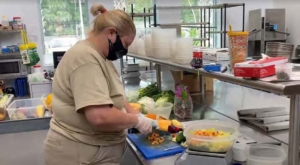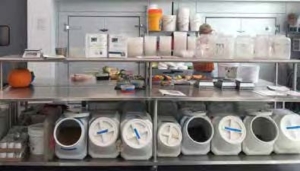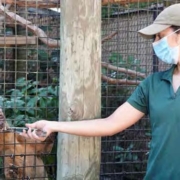The Zoo Kitchen … 4 Things No One Tells You About by Ann Moss
Animals at a zoo are bougie. Their menus should be five-star rated. As a volunteer in the zoo kitchen at Naples Zoo, I help prepare animal diets. Yep. That means I chop, dice, cut, peel and occasionally add a mouse or two to dinner — sometimes, exactly 20 fat crickets. Yum!
Work in the commissary is surprisingly cathartic because you work with specific recipes designed for each animal – weighed to the gram, ounce, or pound. Concentration is key. Hours pass before you glance at the clock. It’s a good gig for both the workers and the animals. Let’s take a quick look at a zoo kitchen.
First— The Zoo Kitchen Is A Big Deal
 Not surprisingly, the animals eat every day — most eat twice a day. Holidays, hurricane days, rain days — the kitchen never shuts down. Knowing what and how much to feed each animal is a science and a well-respected profession called Animal Nutrition. The Washington National Zoo notes that “Clinical nutrition includes balancing diets for all of the animals based on life stages, health issues and transitions from one facility to another… this provides the information keepers use to make rational, science-based nutrition decisions.”
Not surprisingly, the animals eat every day — most eat twice a day. Holidays, hurricane days, rain days — the kitchen never shuts down. Knowing what and how much to feed each animal is a science and a well-respected profession called Animal Nutrition. The Washington National Zoo notes that “Clinical nutrition includes balancing diets for all of the animals based on life stages, health issues and transitions from one facility to another… this provides the information keepers use to make rational, science-based nutrition decisions.”
Additionally, a zoo’s kitchen has a generous budget to accommodate the many dietary needs and fresh food required. Depending on the zoo, annual costs for food might total $65,000+ per year.
Second — The Animals Eat Better Than Most People Here’s a peek at what their menu might look like and what they eat:
Fresh Produce – veggies, fruit, and greens – it looks a lot like your refrigerator should! Who eats this? Herbivores: bears, giraffes, primates, antelope, and tortoises.
Meat — Chunk meat, ground specialty blends, chicken, and such Who eats this? Carnivores: lions, honey badgers, hyenas, coyotes,
and others.
Grains, hay, browse (browse is tree branches trimmed from acacia trees for giraffe) Who eats this? Hoof stock: giraffe, antelope, deer, and others. Mice, rats, crickets, worms, and fish are yummy treats. Who eats this? Birds of prey, snakes, lizards, alligators, and more.
Take a look at some personalized diets measured by the gram, ounce, or pound, chopped to “size” so it is easy for the animal to
manage. The Cotton Top Tamarin, a delicate primate, has their food measured by the gram and cut into small chunks so they can hold the fruit with a tiny hand and nibble.
At the other extreme, a lion might get 5 pounds of meat cut into palm-sized chunks along with 5 pounds of specialty ground meat
with maybe a tad of chicken on the side. Alligators enjoy hand-sized, bone-in chicken chunks, meat, special gator biscuits, and a few fish cut into thirds for training. (Yup. Alligators can be trained!)
Third— Cleaning Protocols In The Kitchen Are Specific
 The number one rule in the Kitchen is: Do Not Cross Contaminate.
The number one rule in the Kitchen is: Do Not Cross Contaminate.
To prevent cross-contamination and pathogens that cause illnesses such as salmonella and E. coli—meat, poultry, and seafood never cross paths with produce and grains. That means there are separate areas and utensils used respectively for meat, grains, and produce. Every day a commercial sanitizing dishwasher washes kitchen tools, cutting boards, and containers. Each prep station is disinfected with a solution that is changed every so often to ensure resistance to pathogens does not occur.
Fourth— Just Like Us, Animals Get Bored And Need Enrichment Enrichment at a zoo includes various ways to imitate natural animal behaviors and often includes food prepared in the kitchen.
For example, giraffes use their prehensile tongue in the wild to grab upper tree branches, strip the leaves and eat them. Using
enrichment to mimic a natural habitat behavior, cylindrical containers are hung, which includes holes in the sides where the
giraffe use their tongues to access the food. “Many animals… receive whole prey in their diets. Reptiles, birds, and smaller mammal species are fed whole prey, including mice, rabbits, and fish.
Although the carnivores’ diets are always nutritionally complete, providing an entire portion of a carcass, including bones, skin,
connective tissue, and organs, is beneficial to carnivores, who evolved to eat exactly this way.
Eating carcasses takes a lot more time, energy, and work to eat and digest, rather than butchered (or processed) meat. This extra
work has been scientifically shown to improve oral and digestive health, as well as muscle tone.”
The Bottom Line
The zoo kitchen is one of the foundational building blocks of any zoo. An animal nutritionist professionally creates animal diets. The
animals eat fresh fruits, vegetables, grains, meat, mice, rats, crickets, and worms depending on the animal and other factors such as age, species, and general health. The diets are both nutritionally sound and provide enrichment opportunities that mimic behaviors found in a wild environment. In addition, zoo kitchens are probably more sanitized than your kitchen at home!
Look For Aza Accredited Zoos!
 AZA-accredited Zoos must go through a strict evaluation every five years by a specialized committee in zoo operations, animal management, and veterinary. For example, Naples Zoo has been an AZA-accredited zoo since 2001.
AZA-accredited Zoos must go through a strict evaluation every five years by a specialized committee in zoo operations, animal management, and veterinary. For example, Naples Zoo has been an AZA-accredited zoo since 2001.
https://nationalzoo.si.edu/animals/animal-nutrition-science
https://www.aza.org/nutrition-scientific-advisory-group
https://www.aza.org/becoming-accredited
https://www.dakotazoo.org/at-the-zoo/animal_food/




Leave a Reply
Want to join the discussion?Feel free to contribute!